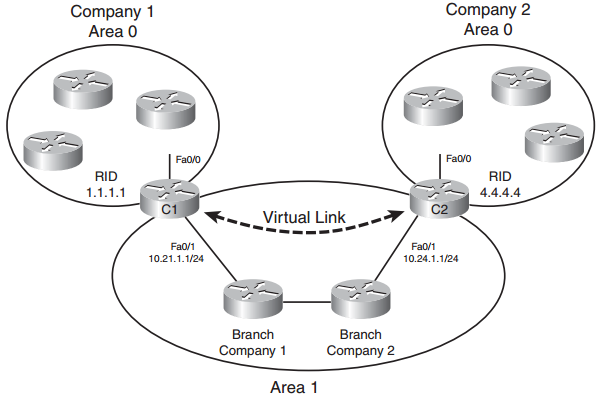CCNP Route FAQ: OSPF Virtual Links and Frame Reay Operations
Figure: Connecting Two Area 0s with a Virtual Link
Q1. Which of the following answers can be verified as true based on the following command output from Router R1?
R1#show ip ospf virtual-links Virtual Link OSPF_VL0 to router 4.4.4.4 is up Run as demand circuit DoNotAge LSA allowed. Transit area 1, via interface FastEthernet0/1, Cost of using 3
a. R1 is configured with an area 0 virtual-link 4.4.4.4 cost 3 command.
b. The ping 4.4.4.4 command on R1 must currently be successful.
c. R1’s Fa0/0 OSPF cost is 3.
d. 4.4.4.4 is known to R1 based on a Type 1 LSA in area 1.
Q2. Several links have been broken so that for the next day or two, what was formerly a contiguous area 0 has been broken into two parts. However, both parts of area 0 have working links into area 1 using routers with RID 1.1.1.1 and 2.2.2.2. Which answers list the command on the router with RID 1.1.1.1 to create a virtual link to help solve this temporary problem?
a. area 0 virtual-link 2.2.2.2
b. area 1 virtual-link 2.2.2.2
c. area 0 source-rid 1.1.1.1 dest-rid 2.2.2.2
d. virtual-link transit-area 1 RID 2.2.2.2
Q3. Router R1 connects to a Frame Relay cloud using a multipoint subinterface, with ten PVCs associated with the subinterface. What command would make this router not use a DR and require static OSPF neighbor definition?
a. ip ospf network broadcast
b. ip ospf network non-broadcast
c. ip ospf network point-to-multipoint
d. ip ospf network point-to-multipoint non-broadcast
Q4. Router R1 connects to a Frame Relay cloud using a multipoint subinterface, with ten PVCs associated with the subinterface. What command would make this router not use a DR, and dynamically discover OSPF neighbors?
a. ip ospf network broadcast
b. ip ospf network non-broadcast
c. ip ospf network point-to-multipoint
d. ip ospf network point-to-multipoint non-broadcast
Q5. Ten routers, R1 through R10, connect in a partial mesh over Frame Relay. For the mesh, R1 and R2 have PVCs connected to all other routers, but Routers R3 through R10 act as branch routers, with only two PVCs–one to R1 and one to R2. The routers use IP subnet 10.1.1.0/24, with addresses 10.1.1.1, 10.1.1.2, and so on, through 10.1.1.10, respectively. The routers all use Inverse ARP to learn Frame Relay mapping information. All routers use a multipoint subinterface with network type point-tomultipoint nonbroadcast. A co-worker’s implementation plan lists lots of configuration commands related to this design. The design states that all hosts should be able to ping all other hosts. Which commands are required for proper functioning of OSPF in this case? (Choose two.)
a. frame-relay map commands on R3–R10 referencing the other routers in this group.
b. Nine OSPF neighbor commands on each router.
c. Nine OSPF neighbor commands on R1 and R2, with only two such commands on R3–R10.
d. R1 and R2 with ip ospf priority 1 commands to ensure they become DR and BDR.
e. R3–R10 with ip ospf priority 0 commands to ensure they do not become DR or BDR.
